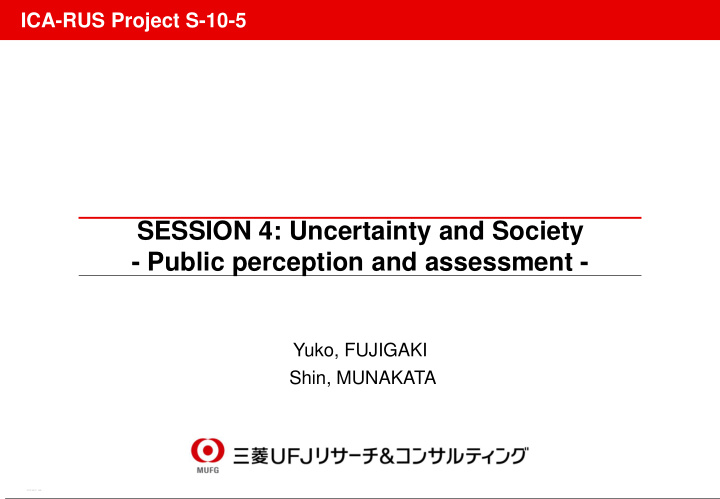



ICA-RUS Project S-10-5 SESSION 4: Uncertainty and Society - Public perception and assessment - Yuko, FUJIGAKI Shin, MUNAKATA 0/9
Part I Classification of public perception Presentation “Public is not a single societal group.” First half of this session was on audience segmentation research and outreach experience in the U.S. Prof. Edward Maibach has administered nation-wide questionnaire survey and interviews since 2008. He showed that public can be classified into 6 segmentation, named “Alarmed”, “Concerned”, “Cautious”, “Disengaged”, “Doubtful” and “Dismissive”. And he characterized each classifications in terms of possibility of further engagement. Though both “Alarmed” and “Dismissive” is hard to change because they employ the slow analytic system when they process risk information, the other classifications have chance to progress because they employ the fast experiential system . At the end of the presentation, he showed the example of education activity and its strategy. 1/9
Part I Classification of public perception Discussion Dr Tsukahara questioned whether the “Dismissive” can be involved in inclusive manner . Prof. Maibach answered that most effective way is not to stimulate them because they often develop negative campaigns. Dr Emori questioned the time scale employed by each classification . Prof. Maibach answered that though only “Doubtful” people typically show the long time scale (grand-grand-children or so) because of advanced age. Dr Munakata questioned the aim of the education activity. Prof. Maibach answered that make “Alarmed” people larger is very important because only the segmentation take actions to mitigate the global warming. Dr Masuda concerned that too much focusing on local event for the sake of outreaching gives incorrect impression of the problem. Prof. Maibach admitted it and explained even “alarmed” shows very limited capacity to understand the correct mechanism. 2/9
Part II Uncertainty assessment and assumption hunting Presentation “Uncertainty is not only the matter of quantity, but also the quality.” The latter half of this session was on method of uncertainty assessment. Prof. Jeroen van der Slujis presented NUSAP method and its applications to two model cases: IMAGE/TIMER B1 case and model chain case. His presentation explains how to conduct pedigree analysis. First, individual experts rate pedigree scores, then, the average of the scores is calculated. He also introduced the examples for identifying assumptions of models. 3/9
Part II Uncertainty assessment and assumption hunting Discussions As discussants, first, Dr. Yamanouchi asked practical questions to develop learning materials for students. For examples, required or expected backgrounds of students, procedures of NUSAP exercise in detail, and applications of this exercise to different issues. Second, Prof. Tsukahara concerned that NUSAP can be used in technocratic approach, and stressed the importance of strengthening the affinity for deliberative democracy. From the floor, many interesting questions were raised: the role of model- simulations to enhance the people’s understandings , ways to handling expert bias, balance between decision support-tool and assessment, implications to responsibilities of scientists, characteristics of Japanese context, and method to encourage public debate. 4/9
Recommend
More recommend